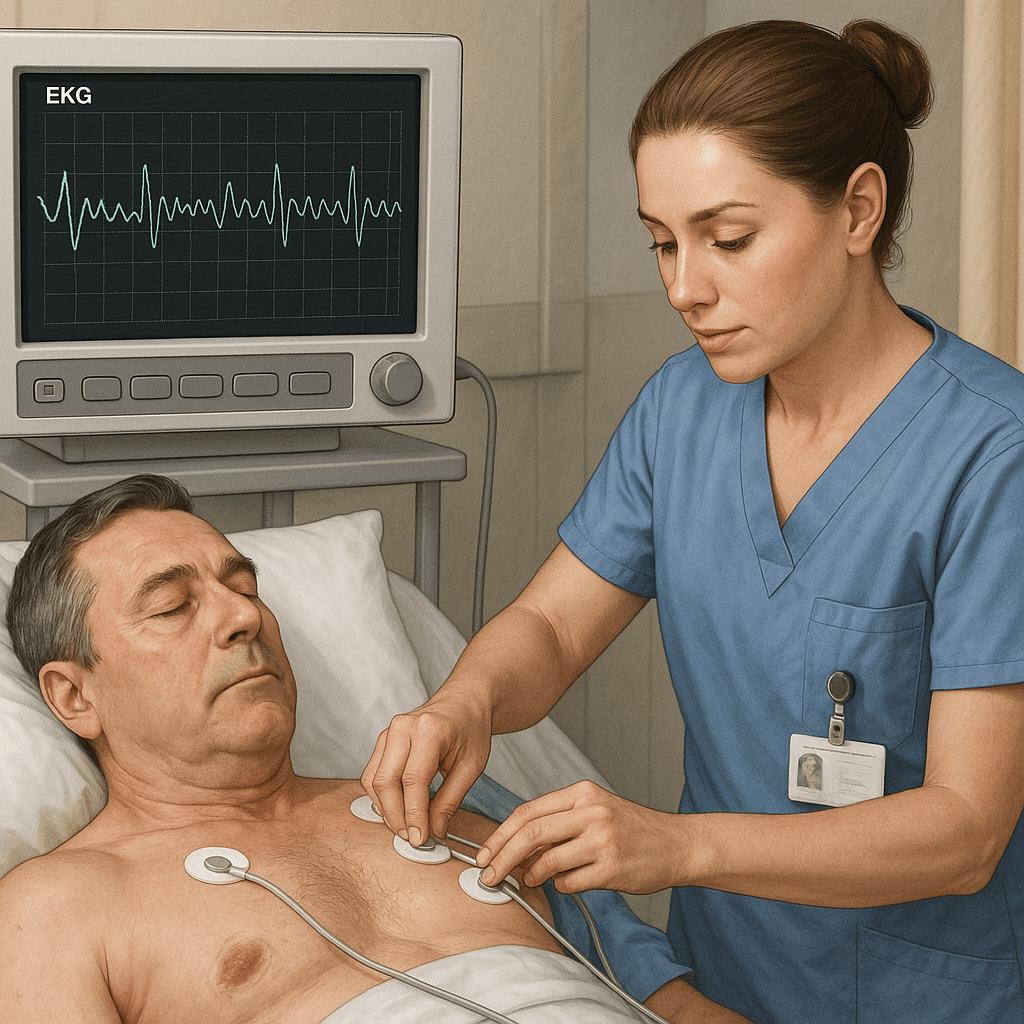Electrocardiogram (EKG or ECG) interpretation is a critical skill for every RN nurse, registered nurse, and nursing student preparing for the NCLEX. While many EKG readings show real cardiac activity, sometimes unusual markings appear on the strip that are not caused by the patient’s heart. These are known as artifacts, and they can confuse both new and experienced nurses.
In this article, we’ll break down what artifact is, its common causes, and how nurses can fix it, making this topic simpler for any nurse or nursing student working through their nursing bundles or exam prep.
What Is Artifact on an EKG?
Artifact refers to false or misleading waveforms that appear on an EKG strip due to interference rather than cardiac activity. Unlike normal P waves, QRS complexes, and T waves, artifact distorts the tracing and can mimic dangerous rhythms, which is why every registered nurse must know how to identify and correct it.
For example, an artifact may look like ventricular tachycardia (V-tach) or atrial fibrillation (A-fib), but in reality, it’s just interference.
Common Causes of Artifact
Artifacts can come from multiple sources. As a nurse, here are the main culprits you should know:
1. Patient Movement
- Tremors, shivering, or even talking can create shaky lines.
- Nurses often see this in patients with Parkinson’s disease or hypothermia.
2. Poor Electrode Placement
- Dry, loose, or misplaced electrodes cause poor contact.
- Registered nurses must always check that electrodes stick well to clean, dry skin.
3. Electrical Interference
- Cell phones, IV pumps, or nearby equipment can disrupt signals.
- This is why nurses ensure cables are properly shielded and away from machines.
4. Muscle Activity (Somatic Tremor)
- Muscle contractions, even from chewing gum, can cause artifact.
- On the NCLEX, this is often shown as wavy baseline interference.
5. Lead Cable Problems
- Broken or tangled leads create false spikes and waves.
How Nurses Fix EKG Artifact
As a registered nurse (RN nurse) or nursing student, knowing how to troubleshoot artifact is part of safe patient care. Here’s a checklist:
✅ Reposition electrodes on clean, dry skin.
✅ Shave hair if necessary for better contact.
✅ Educate the patient to stay still during the test.
✅ Keep lead wires untangled and secured.
✅ Reduce electrical interference by moving devices away.
✅ Warm patients if shivering is causing tremor artifact.
By following these steps, nurses ensure accurate monitoring, which is essential for recognizing real life-threatening arrhythmias.
NCLEX Tip for Nursing Students
On the NCLEX, questions about artifact often test your ability to distinguish artifact from true arrhythmias.
💡 Remember:
- Artifact does not follow cardiac patterns.
- Always assess the patient first, not just the monitor.
- If the patient is stable and the rhythm looks odd, suspect artifact before calling a code.
Why This Matters for Nurses
For a registered nurse, avoiding misinterpretation of artifact prevents unnecessary alarms, false interventions, and patient anxiety. For nursing students, mastering artifact recognition strengthens EKG skills and boosts NCLEX readiness.
If you’re studying with a nursing bundle like the EKG Nursing Bundle 2025, artifact recognition is a must-have skill before stepping into clinical practice.
Final Thoughts
Artifact on EKG strips is a common but preventable issue. By learning to recognize its causes and applying simple fixes, every nurse, RN nurse, and nursing student can ensure accurate cardiac monitoring. Whether you’re preparing for the NCLEX or practicing as a registered nurse, mastering artifact troubleshooting will improve patient safety and boost your confidence in nursing care.
🔹 FAQs
Artifact is interference on an EKG tracing caused by patient movement, poor electrode placement, or external factors, not the heart’s electrical activity.
Nurses can fix artifact by repositioning electrodes, keeping leads untangled, reducing electrical interference, and educating patients to remain still.
NCLEX questions test a nurse’s ability to distinguish artifact from dangerous arrhythmias. Recognizing artifact prevents unnecessary interventions.
Yes, artifact can mimic arrhythmias like V-tach or A-fib, which is why nurses must always assess the patient first, not just the monitor.

